MAR 4424 Assignment 2: Tesla Motors Market Entry Strategy in India
VerifiedAdded on 2023/01/19
|7
|1211
|36
Report
AI Summary
This report analyzes various market entry strategies for Tesla Motors' expansion into the Indian market. It begins with an introduction to Tesla and the significance of the Indian automobile industry. The report then explores the advantages and disadvantages of different market entry strategies, including exporting, licensing, joint ventures, equity stakes, and full ownership. The core of the report focuses on determining the best-suited strategy for Tesla in India, with a detailed rationale provided, highlighting the benefits of joint ventures in navigating cultural differences and bureaucratic challenges while leveraging the expertise of Indian partners. The report concludes by emphasizing the effectiveness of joint ventures for Tesla's successful entry into the Indian market, supported by examples of successful joint ventures in the country.
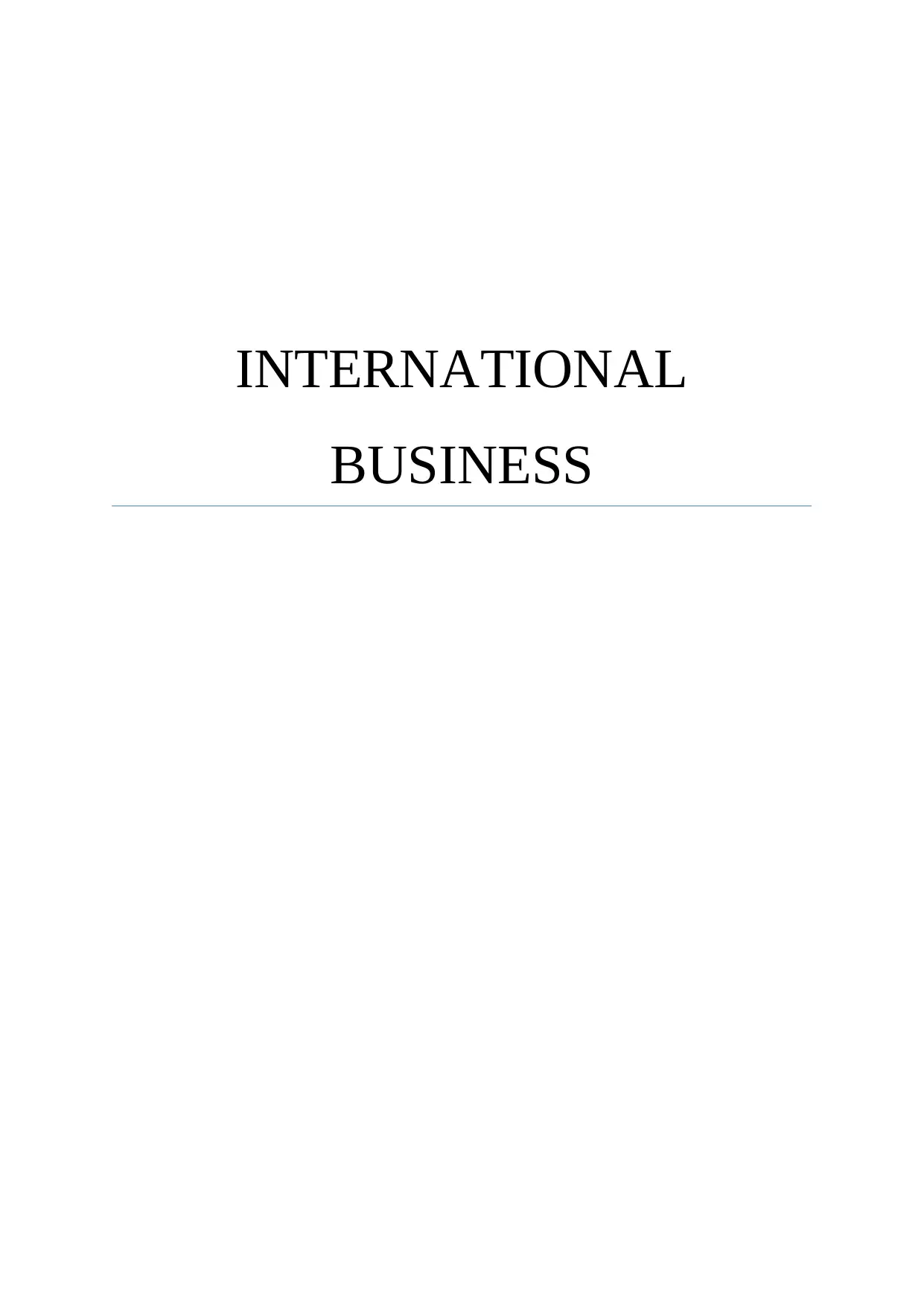
INTERNATIONAL
BUSINESS
BUSINESS
Paraphrase This Document
Need a fresh take? Get an instant paraphrase of this document with our AI Paraphraser

1
Contents
Introduction................................................................................................................................1
Advantages and disadvantages of different market entry strategies..........................................1
Best suited market entry strategy...............................................................................................2
Conclusion..................................................................................................................................3
REFERENCES...........................................................................................................................3
Contents
Introduction................................................................................................................................1
Advantages and disadvantages of different market entry strategies..........................................1
Best suited market entry strategy...............................................................................................2
Conclusion..................................................................................................................................3
REFERENCES...........................................................................................................................3
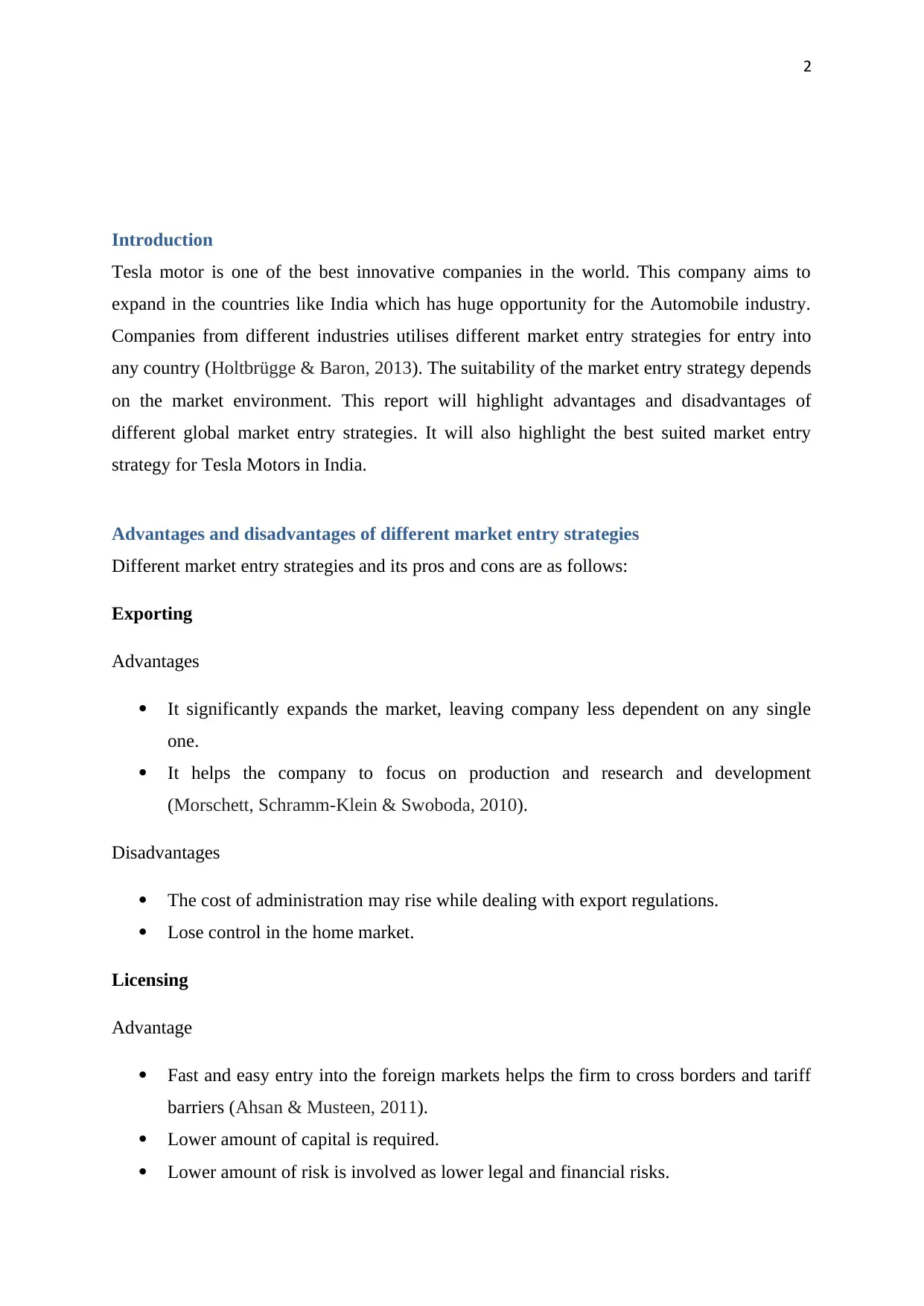
2
Introduction
Tesla motor is one of the best innovative companies in the world. This company aims to
expand in the countries like India which has huge opportunity for the Automobile industry.
Companies from different industries utilises different market entry strategies for entry into
any country (Holtbrügge & Baron, 2013). The suitability of the market entry strategy depends
on the market environment. This report will highlight advantages and disadvantages of
different global market entry strategies. It will also highlight the best suited market entry
strategy for Tesla Motors in India.
Advantages and disadvantages of different market entry strategies
Different market entry strategies and its pros and cons are as follows:
Exporting
Advantages
It significantly expands the market, leaving company less dependent on any single
one.
It helps the company to focus on production and research and development
(Morschett, Schramm-Klein & Swoboda, 2010).
Disadvantages
The cost of administration may rise while dealing with export regulations.
Lose control in the home market.
Licensing
Advantage
Fast and easy entry into the foreign markets helps the firm to cross borders and tariff
barriers (Ahsan & Musteen, 2011).
Lower amount of capital is required.
Lower amount of risk is involved as lower legal and financial risks.
Introduction
Tesla motor is one of the best innovative companies in the world. This company aims to
expand in the countries like India which has huge opportunity for the Automobile industry.
Companies from different industries utilises different market entry strategies for entry into
any country (Holtbrügge & Baron, 2013). The suitability of the market entry strategy depends
on the market environment. This report will highlight advantages and disadvantages of
different global market entry strategies. It will also highlight the best suited market entry
strategy for Tesla Motors in India.
Advantages and disadvantages of different market entry strategies
Different market entry strategies and its pros and cons are as follows:
Exporting
Advantages
It significantly expands the market, leaving company less dependent on any single
one.
It helps the company to focus on production and research and development
(Morschett, Schramm-Klein & Swoboda, 2010).
Disadvantages
The cost of administration may rise while dealing with export regulations.
Lose control in the home market.
Licensing
Advantage
Fast and easy entry into the foreign markets helps the firm to cross borders and tariff
barriers (Ahsan & Musteen, 2011).
Lower amount of capital is required.
Lower amount of risk is involved as lower legal and financial risks.
⊘ This is a preview!⊘
Do you want full access?
Subscribe today to unlock all pages.

Trusted by 1+ million students worldwide
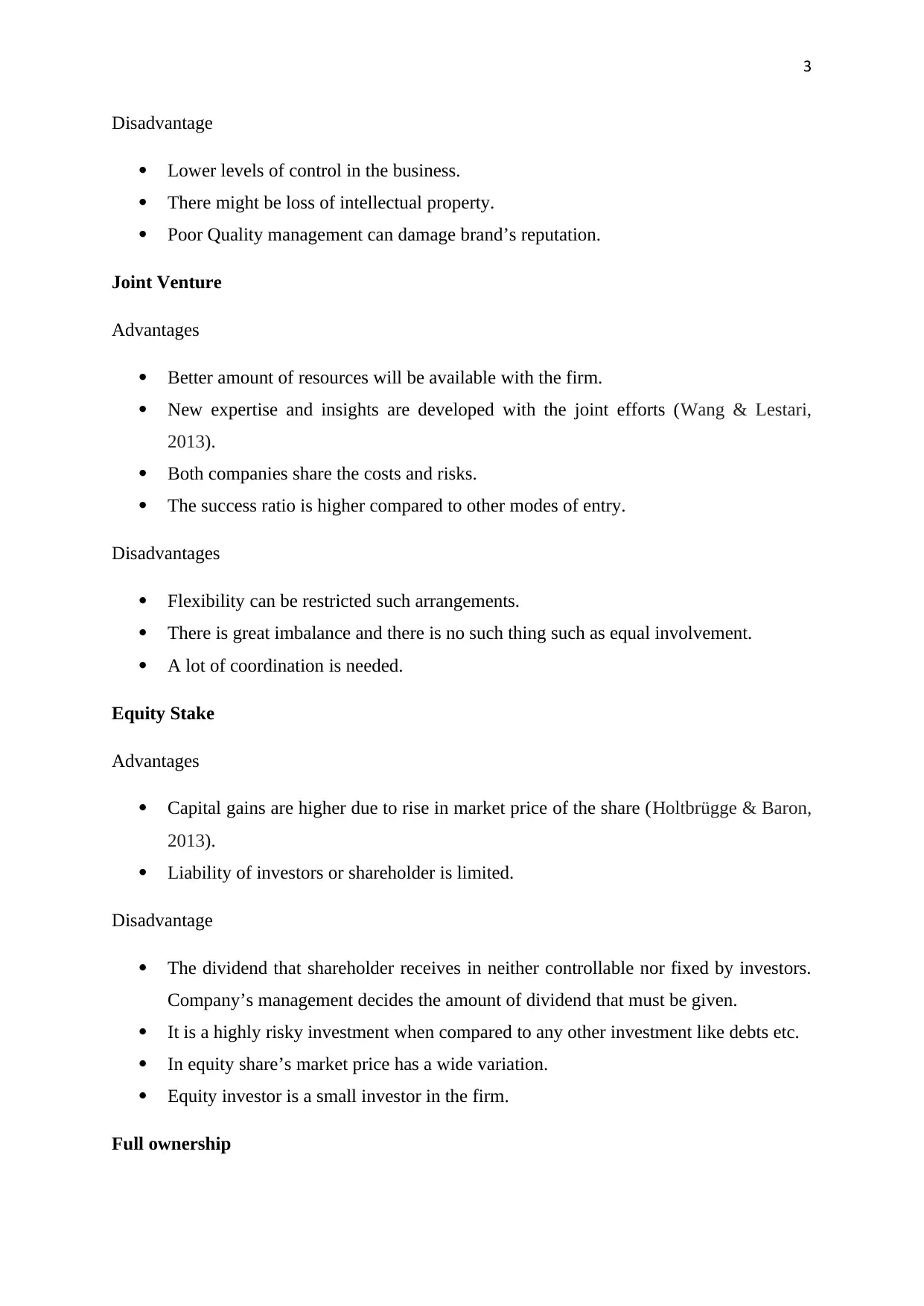
3
Disadvantage
Lower levels of control in the business.
There might be loss of intellectual property.
Poor Quality management can damage brand’s reputation.
Joint Venture
Advantages
Better amount of resources will be available with the firm.
New expertise and insights are developed with the joint efforts (Wang & Lestari,
2013).
Both companies share the costs and risks.
The success ratio is higher compared to other modes of entry.
Disadvantages
Flexibility can be restricted such arrangements.
There is great imbalance and there is no such thing such as equal involvement.
A lot of coordination is needed.
Equity Stake
Advantages
Capital gains are higher due to rise in market price of the share (Holtbrügge & Baron,
2013).
Liability of investors or shareholder is limited.
Disadvantage
The dividend that shareholder receives in neither controllable nor fixed by investors.
Company’s management decides the amount of dividend that must be given.
It is a highly risky investment when compared to any other investment like debts etc.
In equity share’s market price has a wide variation.
Equity investor is a small investor in the firm.
Full ownership
Disadvantage
Lower levels of control in the business.
There might be loss of intellectual property.
Poor Quality management can damage brand’s reputation.
Joint Venture
Advantages
Better amount of resources will be available with the firm.
New expertise and insights are developed with the joint efforts (Wang & Lestari,
2013).
Both companies share the costs and risks.
The success ratio is higher compared to other modes of entry.
Disadvantages
Flexibility can be restricted such arrangements.
There is great imbalance and there is no such thing such as equal involvement.
A lot of coordination is needed.
Equity Stake
Advantages
Capital gains are higher due to rise in market price of the share (Holtbrügge & Baron,
2013).
Liability of investors or shareholder is limited.
Disadvantage
The dividend that shareholder receives in neither controllable nor fixed by investors.
Company’s management decides the amount of dividend that must be given.
It is a highly risky investment when compared to any other investment like debts etc.
In equity share’s market price has a wide variation.
Equity investor is a small investor in the firm.
Full ownership
Paraphrase This Document
Need a fresh take? Get an instant paraphrase of this document with our AI Paraphraser
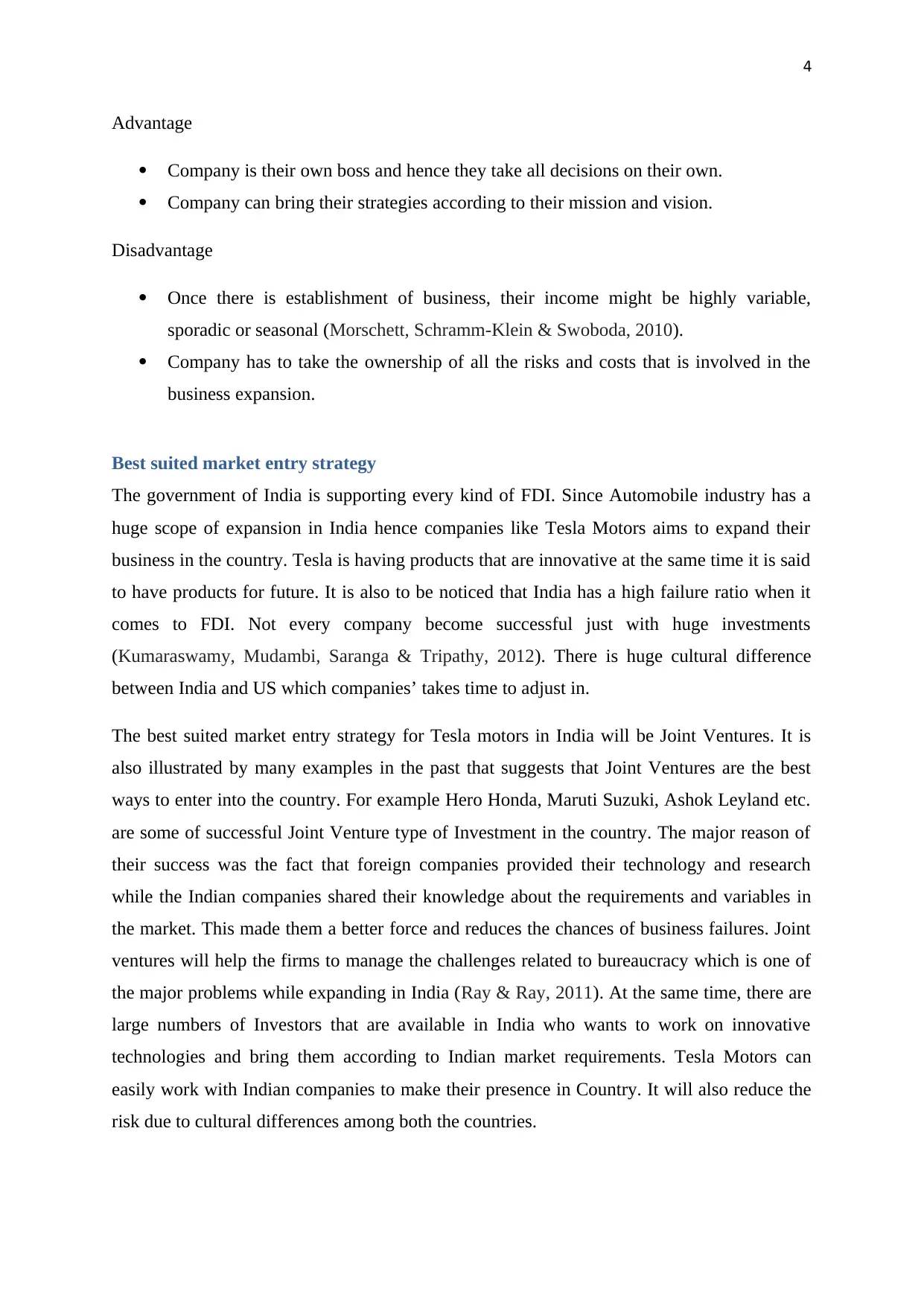
4
Advantage
Company is their own boss and hence they take all decisions on their own.
Company can bring their strategies according to their mission and vision.
Disadvantage
Once there is establishment of business, their income might be highly variable,
sporadic or seasonal (Morschett, Schramm-Klein & Swoboda, 2010).
Company has to take the ownership of all the risks and costs that is involved in the
business expansion.
Best suited market entry strategy
The government of India is supporting every kind of FDI. Since Automobile industry has a
huge scope of expansion in India hence companies like Tesla Motors aims to expand their
business in the country. Tesla is having products that are innovative at the same time it is said
to have products for future. It is also to be noticed that India has a high failure ratio when it
comes to FDI. Not every company become successful just with huge investments
(Kumaraswamy, Mudambi, Saranga & Tripathy, 2012). There is huge cultural difference
between India and US which companies’ takes time to adjust in.
The best suited market entry strategy for Tesla motors in India will be Joint Ventures. It is
also illustrated by many examples in the past that suggests that Joint Ventures are the best
ways to enter into the country. For example Hero Honda, Maruti Suzuki, Ashok Leyland etc.
are some of successful Joint Venture type of Investment in the country. The major reason of
their success was the fact that foreign companies provided their technology and research
while the Indian companies shared their knowledge about the requirements and variables in
the market. This made them a better force and reduces the chances of business failures. Joint
ventures will help the firms to manage the challenges related to bureaucracy which is one of
the major problems while expanding in India (Ray & Ray, 2011). At the same time, there are
large numbers of Investors that are available in India who wants to work on innovative
technologies and bring them according to Indian market requirements. Tesla Motors can
easily work with Indian companies to make their presence in Country. It will also reduce the
risk due to cultural differences among both the countries.
Advantage
Company is their own boss and hence they take all decisions on their own.
Company can bring their strategies according to their mission and vision.
Disadvantage
Once there is establishment of business, their income might be highly variable,
sporadic or seasonal (Morschett, Schramm-Klein & Swoboda, 2010).
Company has to take the ownership of all the risks and costs that is involved in the
business expansion.
Best suited market entry strategy
The government of India is supporting every kind of FDI. Since Automobile industry has a
huge scope of expansion in India hence companies like Tesla Motors aims to expand their
business in the country. Tesla is having products that are innovative at the same time it is said
to have products for future. It is also to be noticed that India has a high failure ratio when it
comes to FDI. Not every company become successful just with huge investments
(Kumaraswamy, Mudambi, Saranga & Tripathy, 2012). There is huge cultural difference
between India and US which companies’ takes time to adjust in.
The best suited market entry strategy for Tesla motors in India will be Joint Ventures. It is
also illustrated by many examples in the past that suggests that Joint Ventures are the best
ways to enter into the country. For example Hero Honda, Maruti Suzuki, Ashok Leyland etc.
are some of successful Joint Venture type of Investment in the country. The major reason of
their success was the fact that foreign companies provided their technology and research
while the Indian companies shared their knowledge about the requirements and variables in
the market. This made them a better force and reduces the chances of business failures. Joint
ventures will help the firms to manage the challenges related to bureaucracy which is one of
the major problems while expanding in India (Ray & Ray, 2011). At the same time, there are
large numbers of Investors that are available in India who wants to work on innovative
technologies and bring them according to Indian market requirements. Tesla Motors can
easily work with Indian companies to make their presence in Country. It will also reduce the
risk due to cultural differences among both the countries.
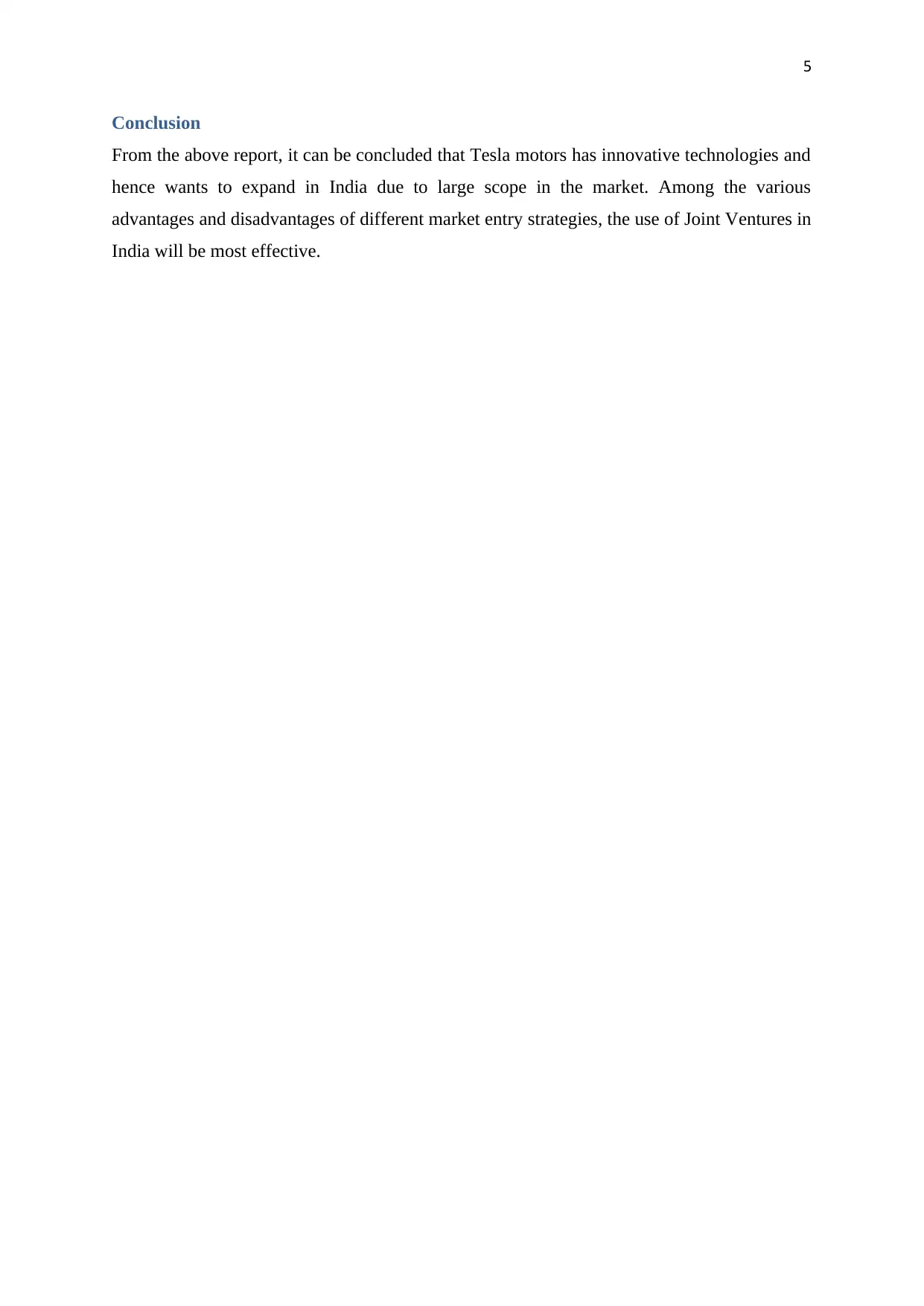
5
Conclusion
From the above report, it can be concluded that Tesla motors has innovative technologies and
hence wants to expand in India due to large scope in the market. Among the various
advantages and disadvantages of different market entry strategies, the use of Joint Ventures in
India will be most effective.
Conclusion
From the above report, it can be concluded that Tesla motors has innovative technologies and
hence wants to expand in India due to large scope in the market. Among the various
advantages and disadvantages of different market entry strategies, the use of Joint Ventures in
India will be most effective.
⊘ This is a preview!⊘
Do you want full access?
Subscribe today to unlock all pages.

Trusted by 1+ million students worldwide
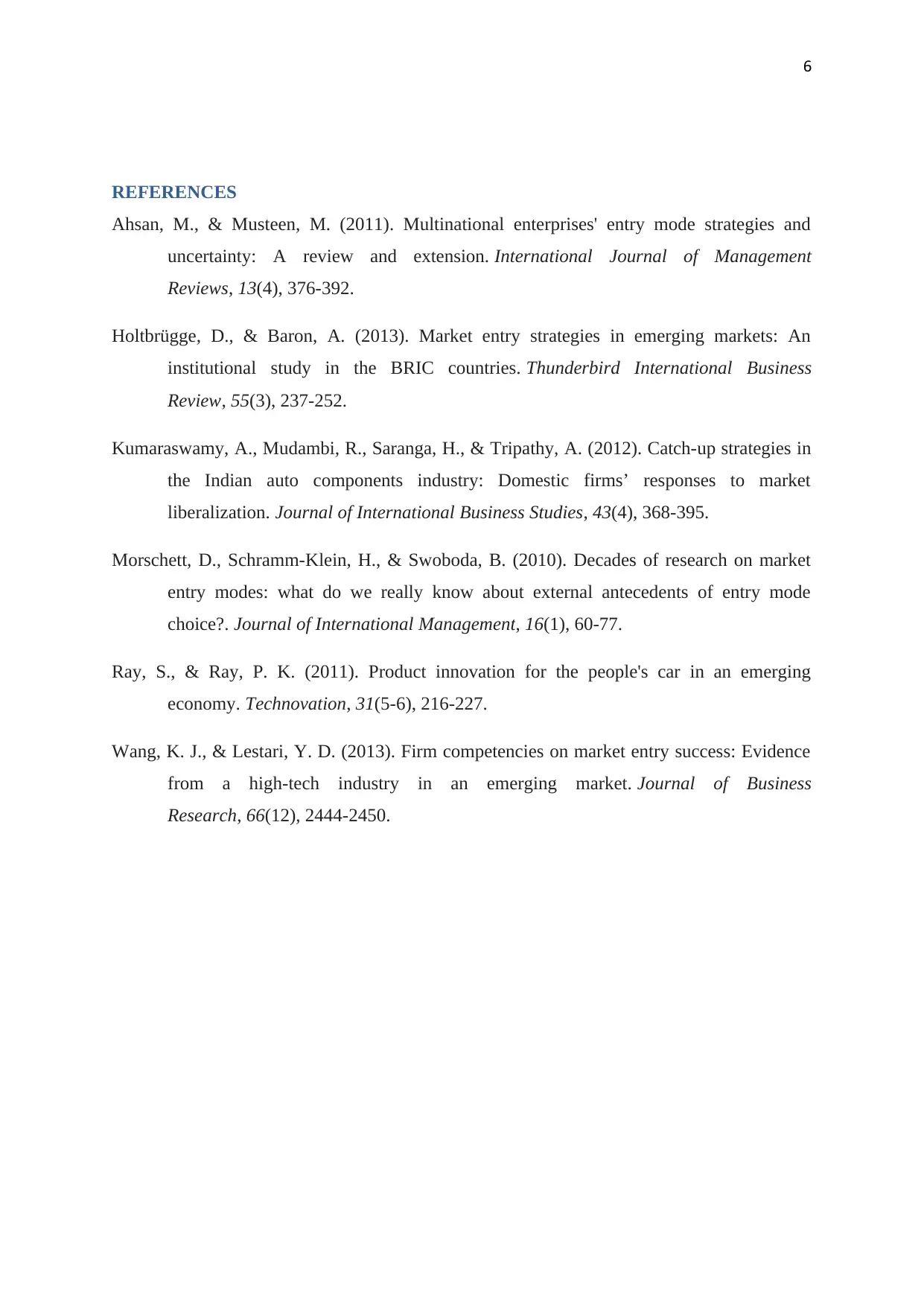
6
REFERENCES
Ahsan, M., & Musteen, M. (2011). Multinational enterprises' entry mode strategies and
uncertainty: A review and extension. International Journal of Management
Reviews, 13(4), 376-392.
Holtbrügge, D., & Baron, A. (2013). Market entry strategies in emerging markets: An
institutional study in the BRIC countries. Thunderbird International Business
Review, 55(3), 237-252.
Kumaraswamy, A., Mudambi, R., Saranga, H., & Tripathy, A. (2012). Catch-up strategies in
the Indian auto components industry: Domestic firms’ responses to market
liberalization. Journal of International Business Studies, 43(4), 368-395.
Morschett, D., Schramm-Klein, H., & Swoboda, B. (2010). Decades of research on market
entry modes: what do we really know about external antecedents of entry mode
choice?. Journal of International Management, 16(1), 60-77.
Ray, S., & Ray, P. K. (2011). Product innovation for the people's car in an emerging
economy. Technovation, 31(5-6), 216-227.
Wang, K. J., & Lestari, Y. D. (2013). Firm competencies on market entry success: Evidence
from a high-tech industry in an emerging market. Journal of Business
Research, 66(12), 2444-2450.
REFERENCES
Ahsan, M., & Musteen, M. (2011). Multinational enterprises' entry mode strategies and
uncertainty: A review and extension. International Journal of Management
Reviews, 13(4), 376-392.
Holtbrügge, D., & Baron, A. (2013). Market entry strategies in emerging markets: An
institutional study in the BRIC countries. Thunderbird International Business
Review, 55(3), 237-252.
Kumaraswamy, A., Mudambi, R., Saranga, H., & Tripathy, A. (2012). Catch-up strategies in
the Indian auto components industry: Domestic firms’ responses to market
liberalization. Journal of International Business Studies, 43(4), 368-395.
Morschett, D., Schramm-Klein, H., & Swoboda, B. (2010). Decades of research on market
entry modes: what do we really know about external antecedents of entry mode
choice?. Journal of International Management, 16(1), 60-77.
Ray, S., & Ray, P. K. (2011). Product innovation for the people's car in an emerging
economy. Technovation, 31(5-6), 216-227.
Wang, K. J., & Lestari, Y. D. (2013). Firm competencies on market entry success: Evidence
from a high-tech industry in an emerging market. Journal of Business
Research, 66(12), 2444-2450.
1 out of 7
Related Documents
Your All-in-One AI-Powered Toolkit for Academic Success.
+13062052269
info@desklib.com
Available 24*7 on WhatsApp / Email
![[object Object]](/_next/static/media/star-bottom.7253800d.svg)
Unlock your academic potential
Copyright © 2020–2025 A2Z Services. All Rights Reserved. Developed and managed by ZUCOL.


